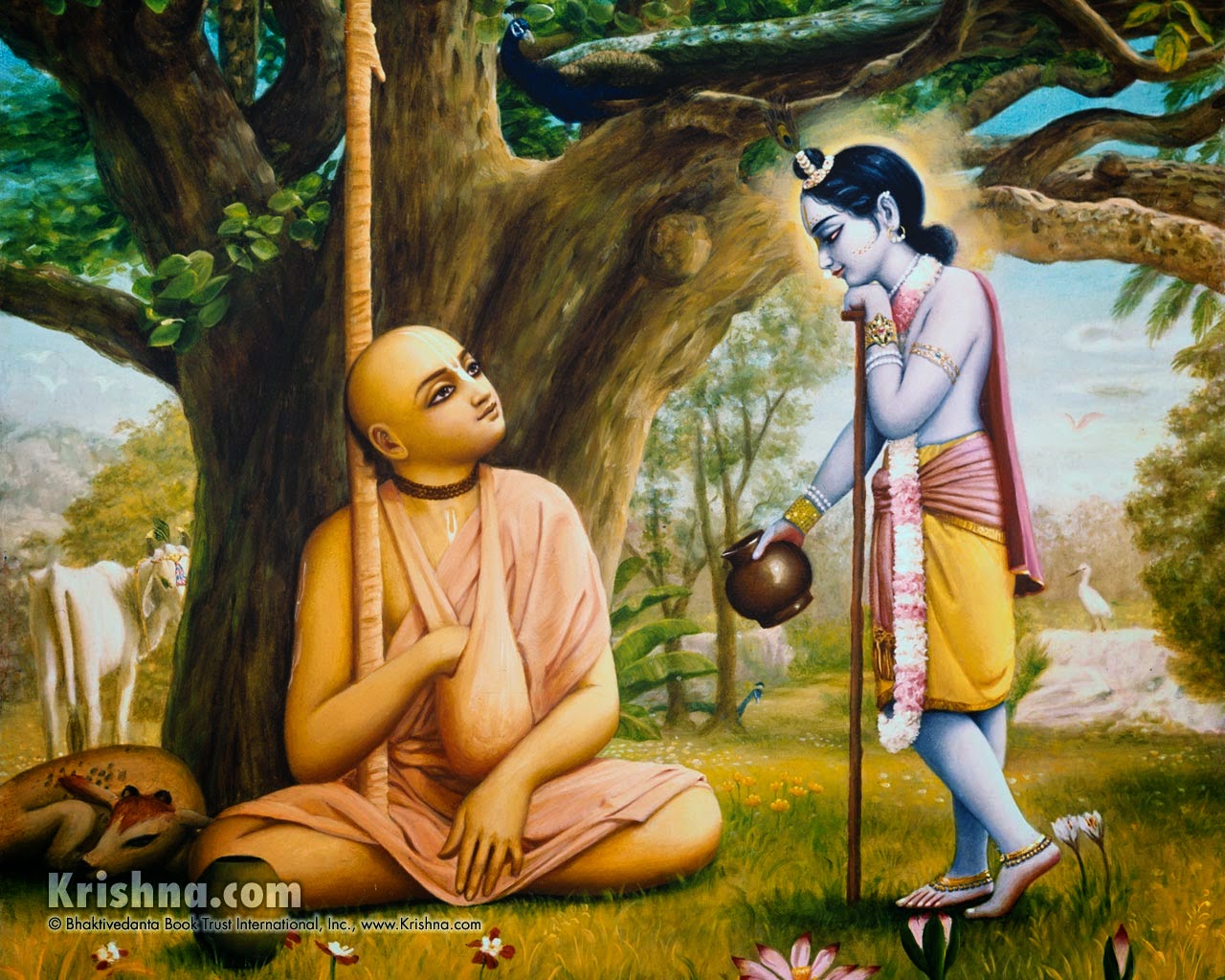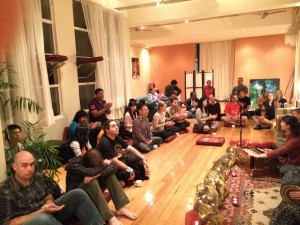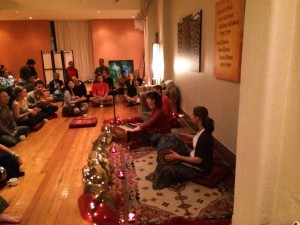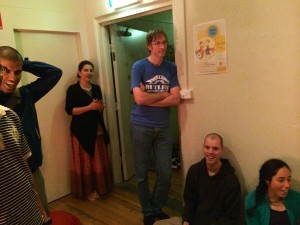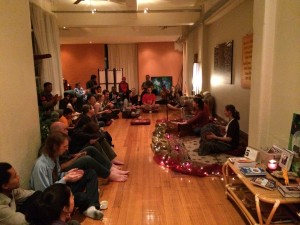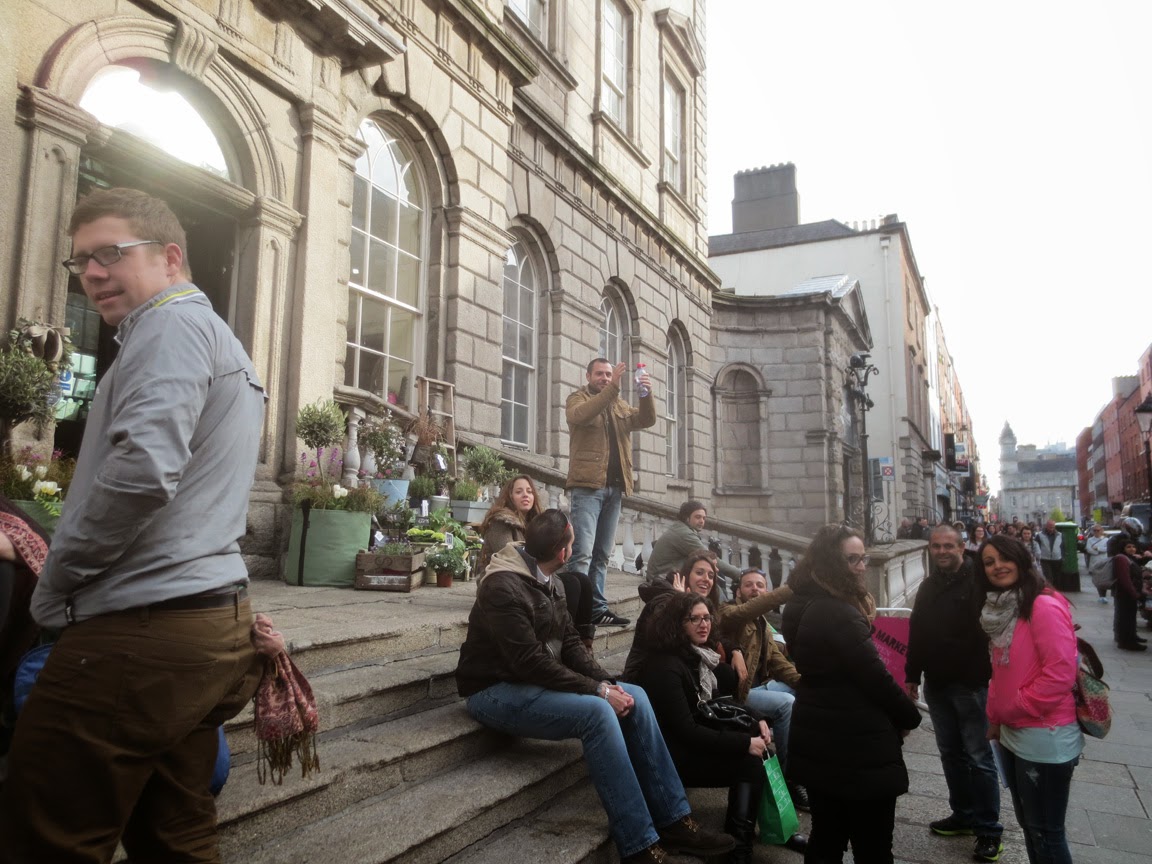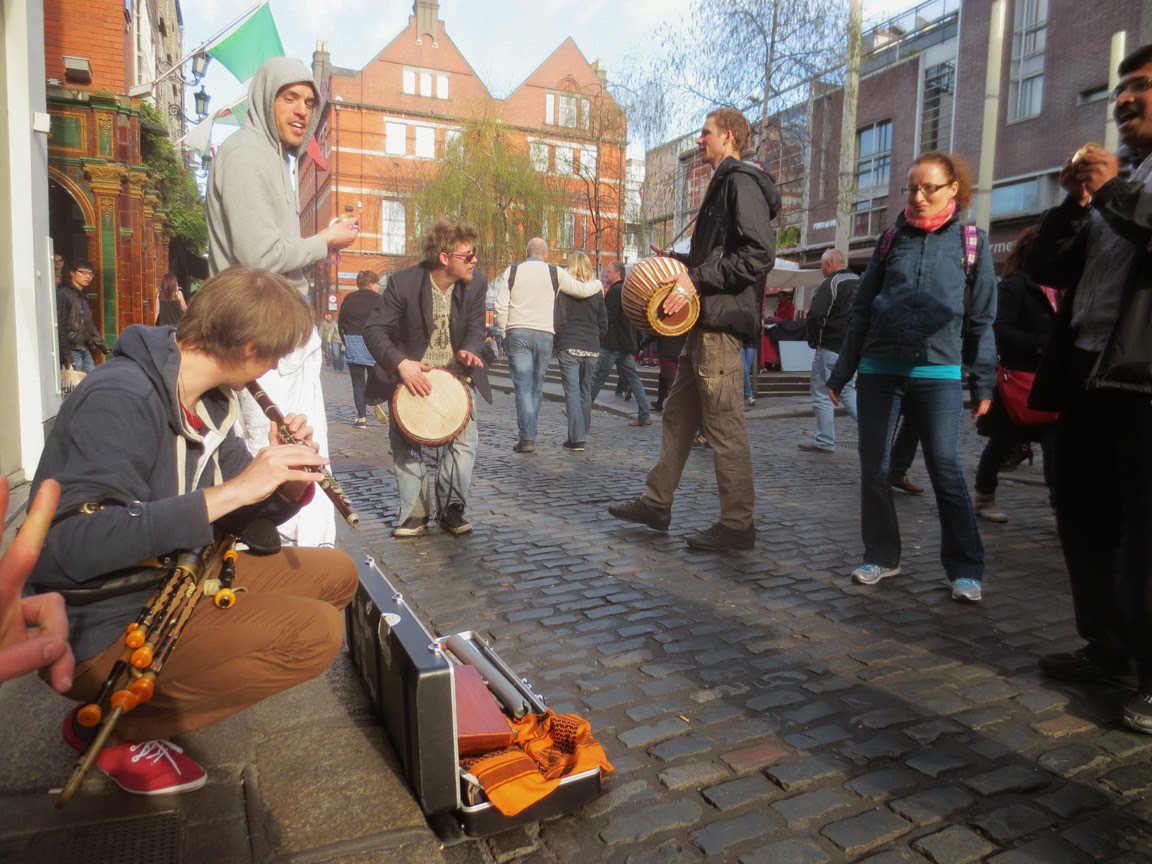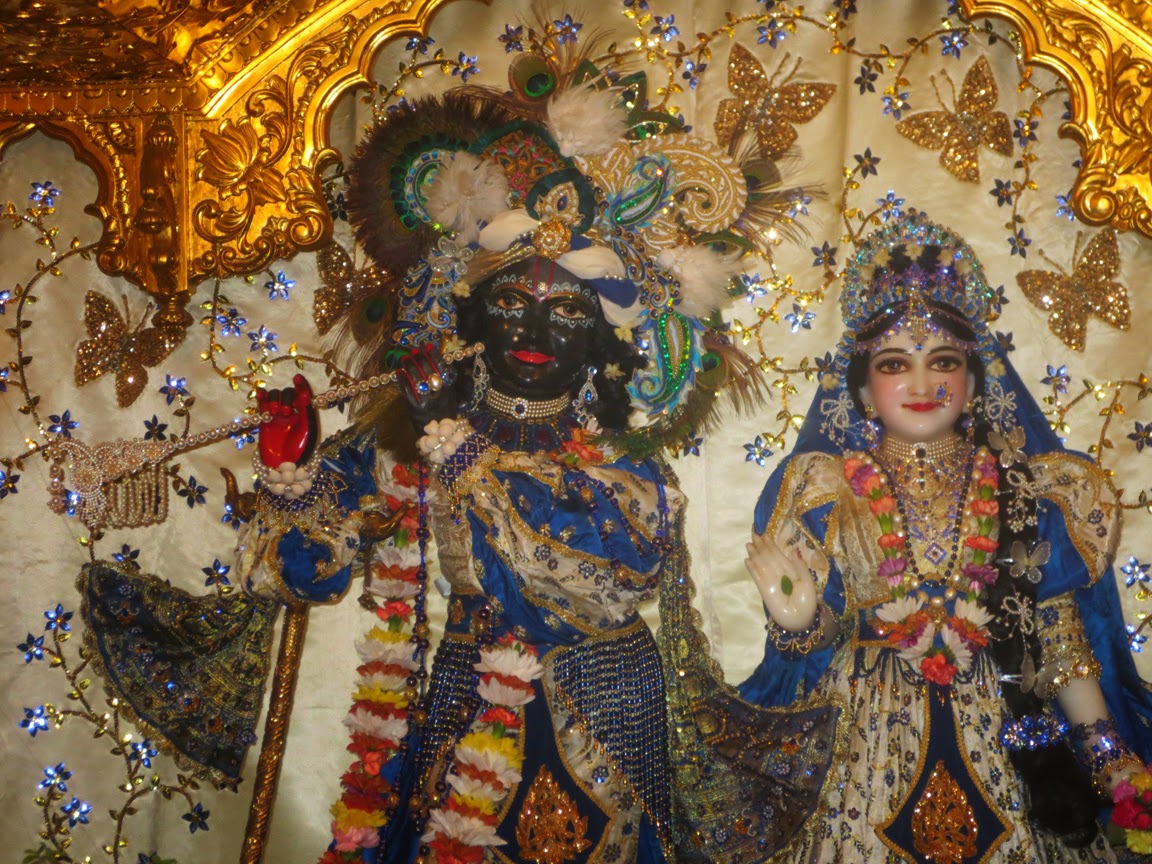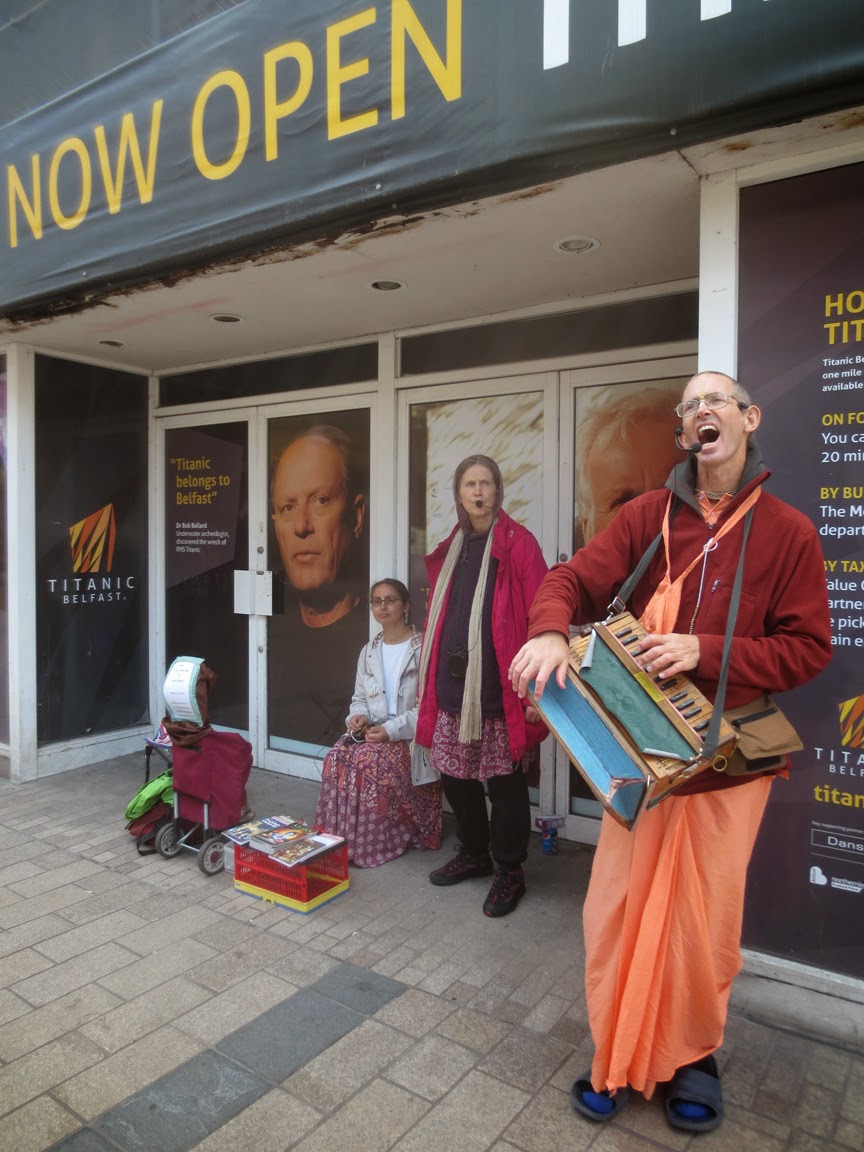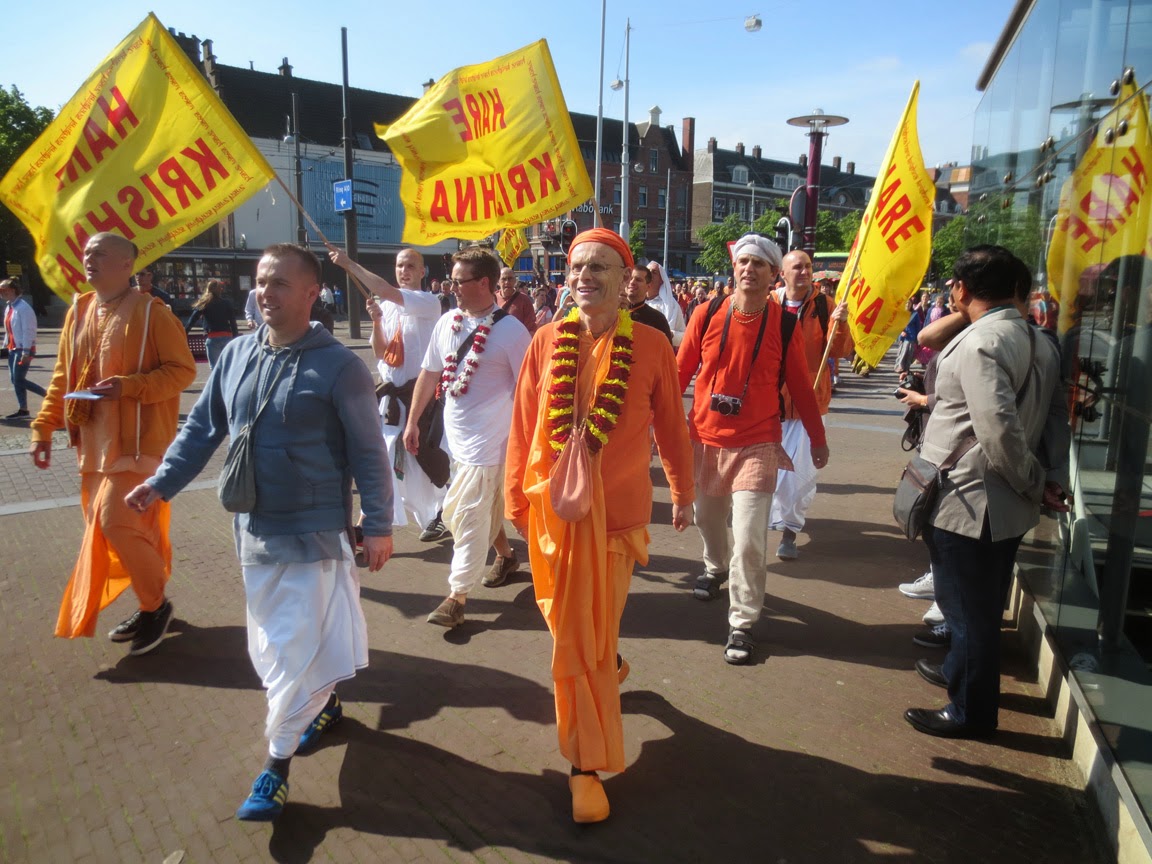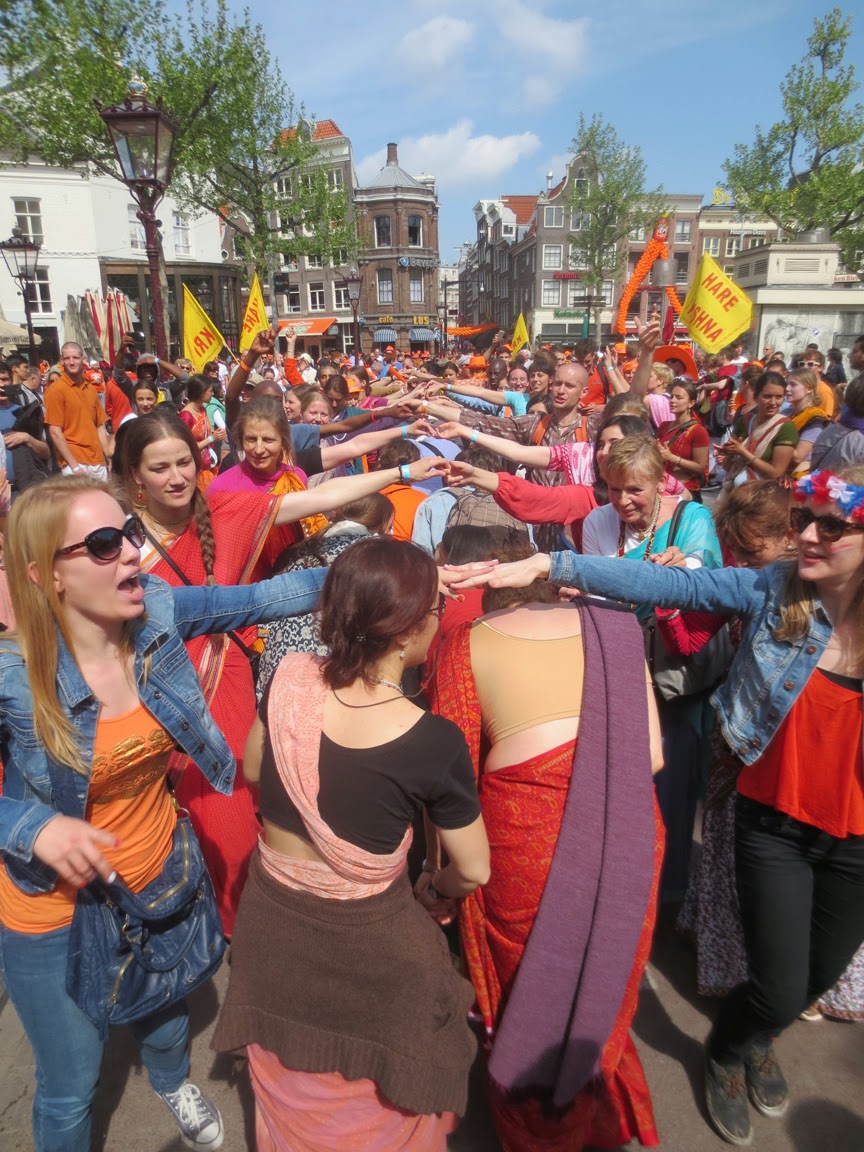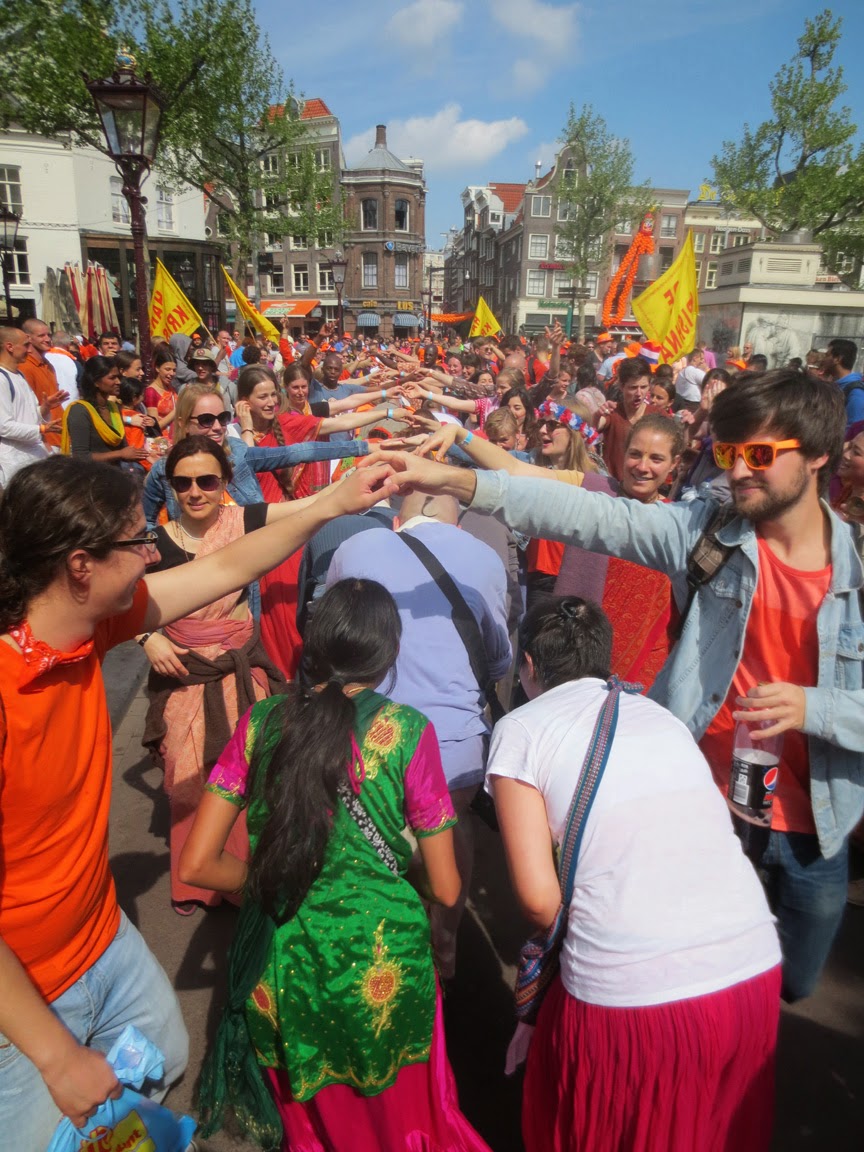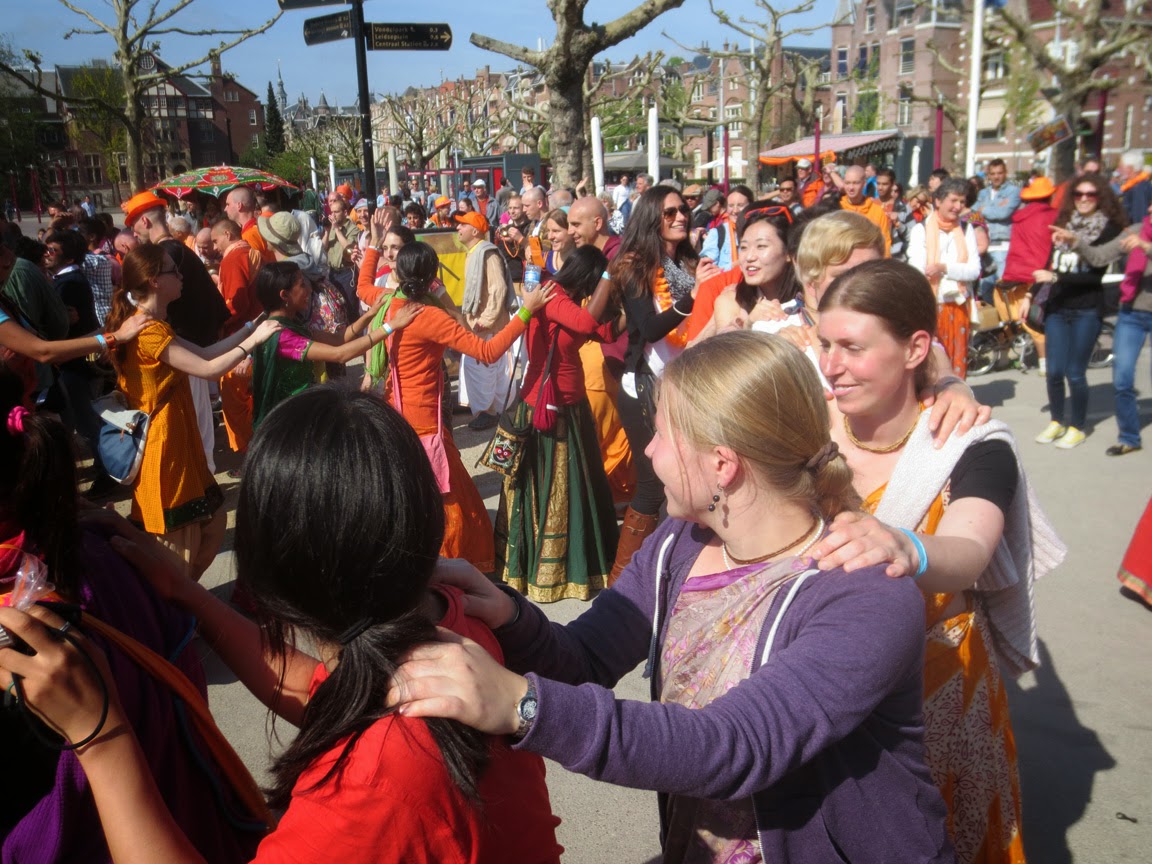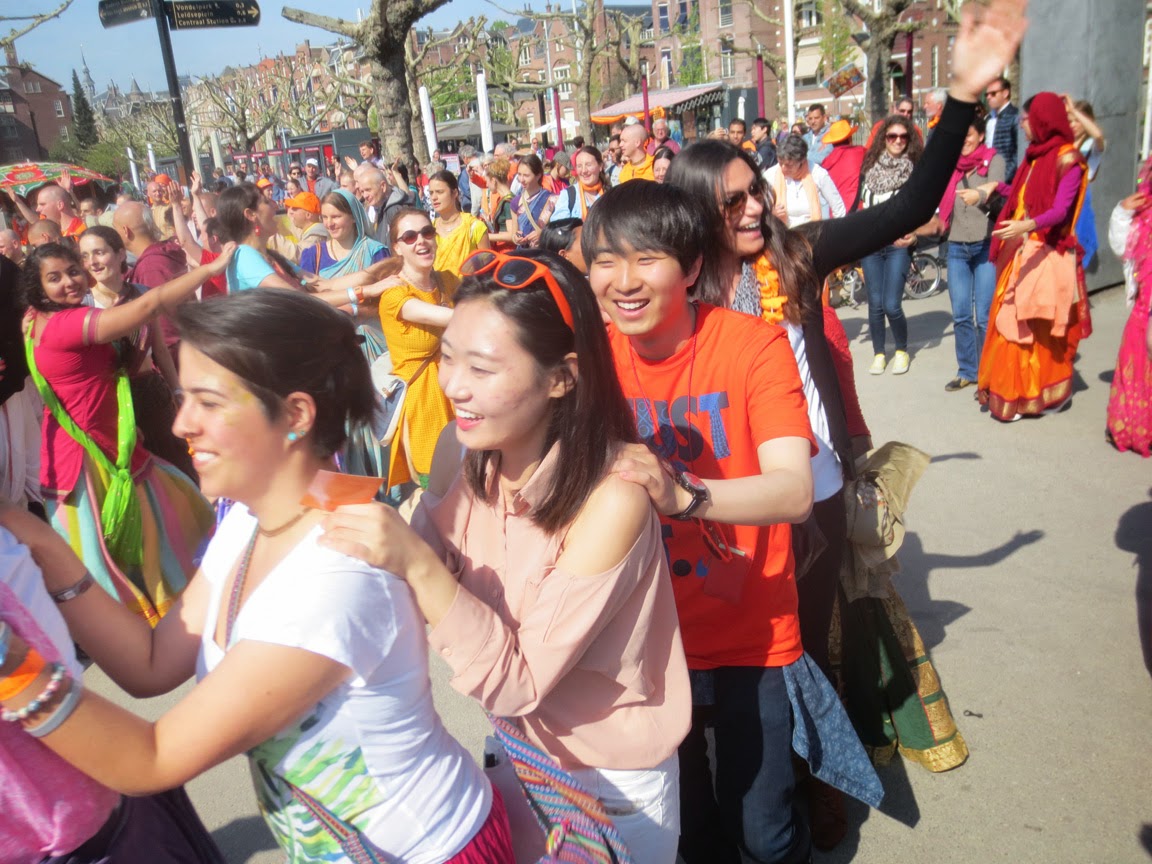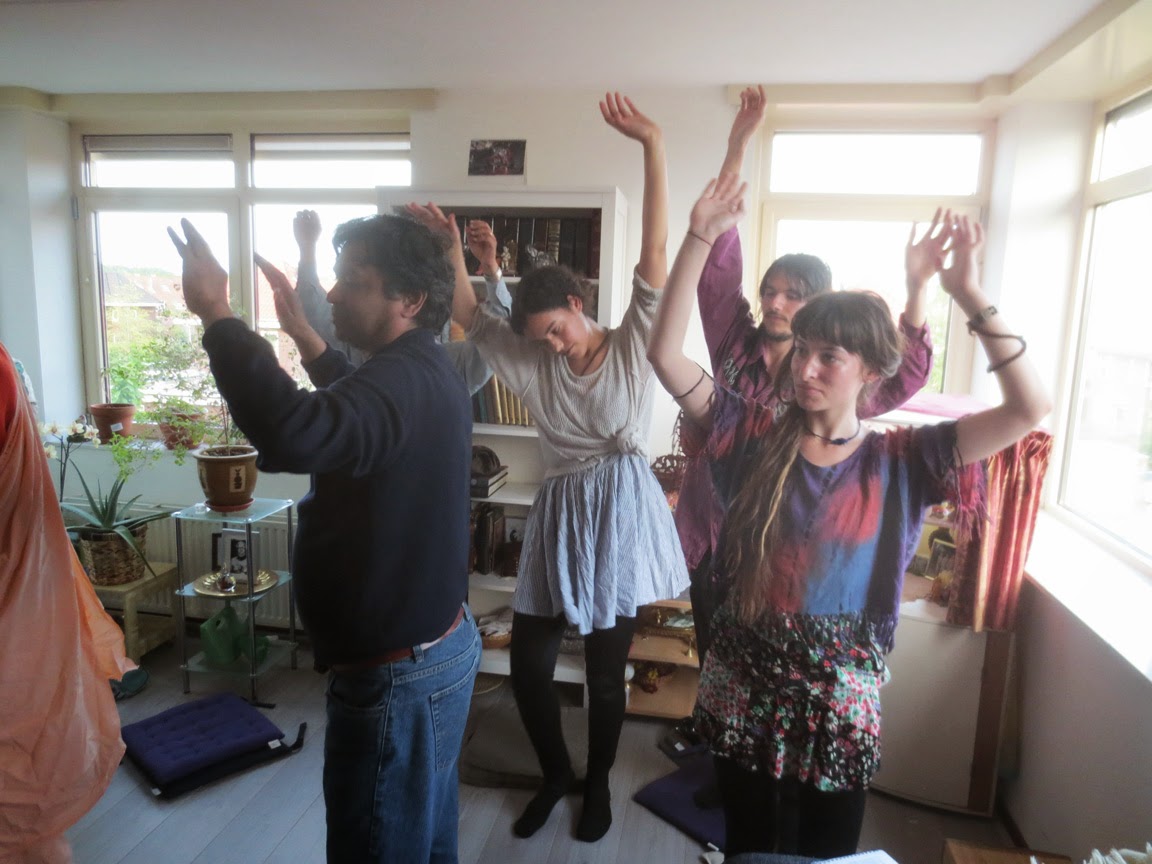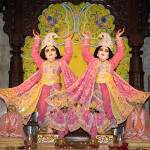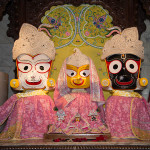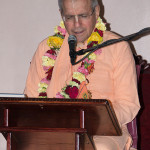When Ashwatthama’s Brahmastra is charging towards Arjuna how does he get time to do achmana and offer prayers to Krishna before countering it?
The abhidha and lakshana potencies of sound
→ The Spiritual Scientist
By arrangement of sound is created a composition. The potency by which the meaning of sound is grasped is called the abhidha potency of the sound or the connotative power of the sound. By using the word "ten" with "elephants" we can understand a certain number of elephants. This direct meaning is called abhidheya. There is another potency of words called "laksana". In the phrase "cowherds on the Ganga," since cowherds cannot stand on the surface of the Ganga's water, by the laksana sakti we understand that the cowherds are on the bank of the Ganga. Where it is necessary to use the laksana sakti, the abhidha sakti does not operate. Where the direct meaning can be used, only the abhidha sakti functions.
Chaitanya Shikshamrita, Bhaktivinoda Thakura
Kirtan Shakti – The Album
→ ISKCON News
Worthy Of My Worship
→ Japa Group
TRANSLATION
Arjuna said: O killer of enemies, O killer of Madhu, how can I counterattack with arrows in battle men like Bhīṣma and Droṇa, who are worthy of my worship?
PURPORT
Respectable superiors like Bhīṣma the grandfather and Droṇācārya the teacher are always worshipable. Even if they attack, they should not be counterattacked. It is general etiquette that superiors are not to be offered even a verbal fight. Even if they are sometimes harsh in behavior, they should not be harshly treated. Then, how is it possible for Arjuna to counterattack them? Would Kṛṣṇa ever attack His own grandfather, Ugrasena, or His teacher, Sāndīpani Muni? These were some of the arguments offered by Arjuna to Kṛṣṇa.
Bhagavad-gītā As It Is 2.4
I Pray For That Success
→ Japa Group
From Bhajan Kutir #77
by Satsvarupa dasa Goswami
Appearance of Lord Nrsimhadeva Festival Tues. May 13, 2014
→ New Vrindaban Brijabasi Spirit
Evening (exact schedule to be announced)
Special Note:
Some of our distinguished presenters mentioned below, from the Festival of Inspiration will be staying on and giving some classes for our annual Nrsimhadev Appearance Festival.
Stay tuned!
Yadunandana Swami
Bhakti Vasudev Swami
Hari Sauri Dasa
Srutakirti Dasa (tentative)
Kirtan Shakti Album to Support Underprivileged Girls in Vrindavana
→ ISKCON News
Personal service
→ KKSBlog
(Kadamba Kanana Swami, 31 March 2014, Cape Town, South Africa, Srimad Bhagavatam 9.5.1)
Personal service is valuable. In the seventh canto, the position of the spiritual master is described. It is mentioned that one must become a menial servant of the spiritual master, render personal service and see that all his personal needs are supplied. And why is that… because it is difficult! In the course of personal service, so many things are required. It has to be particular because each person is particular.
One may himself be a person who likes lots of fresh air but may serve someone who doesn’t; who is different and may like all the windows closed. So, one has to gradually give up his own idea of serving and not serve according to his own standards of what is best; one must gradually learn what are the standards that are best by the person that he is serving. That is quite an adjustment and in that adjustment, one must grow.
This personal service element is mentioned as valuable. Looking after the personal comforts and these things are good and well, but how much personal comfort can a person digest. Sometimes, it is difficult to be the object of so much service. Sometimes, part of the service is to stop serving; that would be a great service because all this service can become too much. So that is also there! One has to know when to and when not to serve.
But more important than personal service is that one takes up the work of the spiritual master… that is most dear to the spiritual master! That work is to somehow or other, spread Krsna consciousness to all the conditioned souls in this world, in various ways. That is most needed and desired. Anyone who takes up that work, he is priyah-krttamah (Bhagavad-gita 18.69), most dear as Krsna says because that is Krsna’s work. That is ultimately real service.
HG Sakshi Gopal Prabhu chanting the Holy Name “old school”
→ simple thoughts
10 May 2014 – Mohini Ekadashi
→ ISKCON Desire Tree
Ask a Hare Krishna: Why are you vegetarian? (3 min video)
→ Dandavats.com
 Vegetarian or "Prasadamarian"? Read more ›
Vegetarian or "Prasadamarian"? Read more › Prabhupada Letters :: Anthology 2014-05-07 12:58:00 →
Prabhupada Letters :: 1947-64
Prabhupada Letters :: Anthology 2014-05-07 12:56:00 →
Prabhupada Letters :: 1947-64
Prabhupada Letters :: Anthology 2014-05-07 12:54:00 →
"In the afternoon there was again meeting for teaching Sanskrit. Tonight Keertan in the Ananda Ashram was very much appreciated by all. Mr. Bill has kept my office copy of Back to Godhead for reading. I came back to 92 Bowery in the car of George."
Prabhupada Journal :: 1966
Prabhupada Letters :: Anthology 2014-05-07 12:49:00 →
Prabhupada Letters :: 1975
Prabhupada Letters :: Anthology 2014-05-07 12:48:00 →
Prabhupada Letters :: 1975
Prabhupada Disciple Profile: Gadagaraja das
→ Dandavats.com
 Gadagaraja prabhu describes the years at The Press in New York as “every second being nectar” due to Srila Prabhupada’s presence and mercy. Prabhupada had said that The Press was “his heart.” The Press moved to Los Angeles in 1974, and Gadagaraja prabhu spent most of his time there until the late 1990’s. In 1975, he participated in the two-month Caitanya Caritamrita marathon where they finished publishing 17-volumes by Srila Prabhupada’s instruction and empowerment. When Srila Prabhupada was around, there was never any impediment. Gadagaraja prabhu would also cook for Govinda’s Restaurant. Throughout the 1980’s and the 1990’s, he also spent extended time at various temples, including Vrindavan, Bombay, Paris, London, Rome, Berkeley, and Chicago. He very much appreciated the mood of European devotees. In the late 80’s, he married Seva Kunja devi dasi, a French devotee, and they had twin girls, Kalindi and Varsana. Read more ›
Gadagaraja prabhu describes the years at The Press in New York as “every second being nectar” due to Srila Prabhupada’s presence and mercy. Prabhupada had said that The Press was “his heart.” The Press moved to Los Angeles in 1974, and Gadagaraja prabhu spent most of his time there until the late 1990’s. In 1975, he participated in the two-month Caitanya Caritamrita marathon where they finished publishing 17-volumes by Srila Prabhupada’s instruction and empowerment. When Srila Prabhupada was around, there was never any impediment. Gadagaraja prabhu would also cook for Govinda’s Restaurant. Throughout the 1980’s and the 1990’s, he also spent extended time at various temples, including Vrindavan, Bombay, Paris, London, Rome, Berkeley, and Chicago. He very much appreciated the mood of European devotees. In the late 80’s, he married Seva Kunja devi dasi, a French devotee, and they had twin girls, Kalindi and Varsana. Read more › A visit to the Noah-Ahimsa animal shelter
→ SivaramaSwami.com
The post A visit to the Noah-Ahimsa animal shelter appeared first on SivaramaSwami.com.
Give Krsna an excuse to save you
→ SivaramaSwami.com
The post Give Krsna an excuse to save you appeared first on SivaramaSwami.com.
A complete and detailed map of Iskcon Vrindavana
→ Dandavats.com
 1-2. Donation & Life
Membership
Offices
3. Welcome Centre
4. Internet Access
5. Matchless Gifts
6. Bhisma Office
7. Vrindavan.tv
8. BBT Book Display
9. Krishna Balarama
Guesthouse
10. Govinda's
Restaurant
11. Legal Office
12. Deity Kitchen
13. Community
Services
14. Security Office
15. Tulasi House
16. Balaram Hall
17. Administration
Offices
18. Radhika's Garden
19. BBT Office
20. Krishna Hall
21. Temple Kitchen
22. Bakery Kitchen
23. Brahmacari
Asrama
24. Namahatta
Preaching Office
25. Marketplace
26. ATM
27. Post Office
28. Gurukula
Read more ›
1-2. Donation & Life
Membership
Offices
3. Welcome Centre
4. Internet Access
5. Matchless Gifts
6. Bhisma Office
7. Vrindavan.tv
8. BBT Book Display
9. Krishna Balarama
Guesthouse
10. Govinda's
Restaurant
11. Legal Office
12. Deity Kitchen
13. Community
Services
14. Security Office
15. Tulasi House
16. Balaram Hall
17. Administration
Offices
18. Radhika's Garden
19. BBT Office
20. Krishna Hall
21. Temple Kitchen
22. Bakery Kitchen
23. Brahmacari
Asrama
24. Namahatta
Preaching Office
25. Marketplace
26. ATM
27. Post Office
28. Gurukula
Read more › Tumut Rathyatra 2014 (Australia) (Album 85 photos)
→ Dandavats.com
 Tumut (Australia) Sri Jagannath Baladeva Subhadra Rathyatra 2014-05-04. ISKCON - Founder Acarya His Divine Grace A.C Bhaktivedanta Swami Srila Prabhupada. With His Holiness Vedavyasapriya Swami. During Tumut's Annual 2014 Festival of the Falling Leaf.
Read more ›
Tumut (Australia) Sri Jagannath Baladeva Subhadra Rathyatra 2014-05-04. ISKCON - Founder Acarya His Divine Grace A.C Bhaktivedanta Swami Srila Prabhupada. With His Holiness Vedavyasapriya Swami. During Tumut's Annual 2014 Festival of the Falling Leaf.
Read more › May 7th, 2014 – Darshan – Chandan Yatra – Day 6
→ Mayapur.com
The post May 7th, 2014 – Darshan – Chandan Yatra – Day 6 appeared first on Mayapur.com.
HG Gaur Gopal Prabhu – SB 10.64.29 – 01.05.2014
→ Gouranga TV - The Hare Krishna video collection
HG Gaur Gopal Prabhu – SB 10.64.29 – 01.05.2014
Devananda Pandit leading New Vrindaban’s Kartik 24 Hour Kirtan – October 19th, 2013
→ New Vrindaban Brijabasi Spirit
Video of Devananda Pandit leading New Vrindaban’s Kartik 24 Hour Kirtan - October 19th, 2013.
HG Narottamananda Prabhu / Kalachandji’s Bhagavad-Gītā Meditation Course – 24
→ Kalachandji's Audio Archive
HG Vishvambhar Prabhu / SB 10.60.40
→ Kalachandji's Audio Archive
HG Narottamananda Prabhu / SB 10.60.39
→ Kalachandji's Audio Archive
See The Beauty – Melissa Ohden – Abortion Survivor
→ ISKCON News
Another Block on the ToVP Dome
→ ISKCON News
ISKCON Scarborough- Recently uploaded videos
→ ISKCON Scarborough
Monday, May 5th, 2014
→ The Walking Monk
Last Day in Halifax
The hearty daffodils stand in all their glory. Even in the dark, early hours, they transcend without sunshine and with mouths wide open. Raccoons screech at each other – a fight no doubt. I can hear them, but I can’t necessarily see them. For years in my travels I’ve heard their sounds, predominantly their whimpering. Then the birds pick up with their morning welcome songs. It’s all awesome, and it really beats the noise of the maddening traffic, when passions kick in and the nocturnal peace that’s punctuated with raccoon party fights is all done. This transition of sound and activity is my observation for many years now on early morning early walks.
Corey and Theresa had us over for lunch. Once again, I’m impressed what a little training has done for younger folks such as the youth. Corey, in particular, travelled with our east coast monks one summer and is now enjoying the lasting and favourable effects. He whipped up this fabulous meal for a group of us. His service mood was excellent. The apartment he and Theresa share is a small oasis of sacred books by Bhaktivedanta Book Trust. They have a modest but beautiful shrine of Krishna deities. They keep a clean place. I see a smooth assimilation of Vedic culture in their lives. I’m happy for this young couple who might otherwise be prone to stay on the grid of sense gratification.
With it being my last day in Halifax, I called on a small ad hoc meeting amongst faithful followers to discuss vision and organization for the sharing of Krishna Consciousness in this neat old city. There’s a rich history here of the acceptance of waves of immigrants at this natural and national port of entry, of taking a major blow when explosives from the harbor went off a century ago, flattening the city, and of a ready response to burying hundreds of corpses, victims of the fateful Titanic. I think we can fit Krishna into the multiple experiences of Haligonians, residents of Halifax.
May the Source be with you!
6 KM
Fascinating Mahabharata Characters online course
→ The Spiritual Scientist
The “Fascinating Mahabharata Characters” course by Chaitanya Charan das covers systematically the biographies of sixteen important Mahabharata characters. Drawing insights from the broad Vedic wisdom-tradition, the course explains their qualities, resolves controversies and demonstrates the perennial relevance of this timeless classic.
The characters covered are:
- Bhishma
- Drona
- Vidura
- Dhritarashtra
- Kunti
- Yudhisthira
- Bhima
- Arjuna
- Nakula
- Sahadeva
- Duryodhana
- Karna
- Draupadi
- Ashwatthama
- Ghatothkacha
- Abhimanyu
To know more about the course, visit www.bhakticourses.com.
What Is The Question Of Mind?
→ Japa Group

When discussing the correct method of chanting japa, Srila Prabhupada generally advised his disciples to "just hear the name." In Bhagavad-gita, Sri Krsna orders Arjuna to do the same, tat srnu, "Just hear Me." Once a disciple told Srila Prabhupada that it is very difficult to control the wandering mind during japa. In reply, Prabhupada said:
From Art Of Chanting Hare Krsna by Mahanidhi Swami
Why are there differences among different religions?
→ The Spiritual Scientist
Different countries have different water, air, mountains, forests, eatables and clothing. Because of this, the people of these places have naturally developed different physiques, complexions, customs, clothing and food. Similarly, the peoples' mentality will differ. And thus various people's ideas of God, though being basically similar, will differ in details. When men in various countries surpass the uncivilized stage and progress to the civilized stage, the scientific stage, the moral stage and the devotional stage, they will develop differences, in language, dress, food, and mentality. This gives rise to difference in the mode of worship of God. Considering the matter objectively, there is no harm in secondary differences. If there is agreement concerning the essential nature of God and His worship, there should be no obstacle in attaining the same result. Thus Mahaprabhu has instructed that we should instruct everyone to worship the pure form of the Lord, but at the same time we should not criticize others' modes of worship.
Because of the above reasons, we see the following differences amongst the religions of different countries.
1. difference of teachers or prophets
2. difference in worshipper's mentality and consequent expression of reverence. 3. difference in procedures of worship
4. difference in conceptions of God
5. difference in God's name and statements due to difference in language
- Chaitanya Shikshamrita, Bhaktivinoda Thakura,
Urban Yoga
→ Ramai Swami
The Urban Yoga program in Melbourne is still going well. It is held on the next floor up from our Crossways restaurant downtown. The devotees teach yoga as well as having kirtan and lecture nights.
The greatest thing
→ KKSBlog
bahūnāḿ janmanām ante
jñānavān māḿ prapadyate
vāsudevaḥ sarvam iti
sa mahātmā su-durlabhaḥ
It is a rare person who, after many many births, is coming to the point where they say,”Krsna is everything,” or “Krsna is the priority in my life.” So initiation stands for that – that Krsna becomes the priority. So that is wonderful. That is actually the greatest thing.
After so many lifetimes of being distracted by so many secondary things, now the most wonderful, ultimately the only wonderful objective, has become the priority in our life. So it is a glorious moment. It is a blissful moment. It is a happy moment. It is a time when we become finally relieved from being misguided and we are taking our steps on the spiritual path which is a blissful path. It is a path that brings us more and more auspiciousness with every step that we take.
So in this way, it is indeed a very important and significant moment.
Travel Journal#10.8: Dublin, Northern Ireland, London, Holland
→ Travel Adventures of a Krishna Monk
By Krishna-kripa das
(April 2014, part two)
(Sent from Newcastle upon Tyne, England, on May 7, 2014)
Thanks to Gopalacarya Prabhu (Govindadvipa), Kevin (Govindadvipa), Premarnava Prabhu (Dublin), Shelina (Govindadvipa), Syamamayi dd (Belfast), and Bhagavati Dasi (Belfast), and Madhava Gauranga Prabhu (Rotterdam) for their kind donations which allow me to continue traveling and promoting the public congregational chanting of the holy name. Thanks to Vicaru Prabhu for the nice pictures of the harinama in London.
Govindadvipa, the Krishna Island in Northern Ireland
In descriptions of Krishna’s abode, Goloka Vrndavana, in the spiritual world, animals such as deer and peacocks are found, and these animals can be found at Govindadvipa as well.
One nice devotee lady, Karunesvari dd, who plays the harmonium, did an excellent job singing much of the time.
My friends Kevin and Shelina, who I met doing Bhakti-sastri in Mayapur, came out with their son, Tukarama, demonstrating that harinama can be a family affair.
To see the photos which I did not include in this blog, many of which are from the King’s Day harinama in Amsterdam, click on the link below or copy it to your web browser [note that the unused pictures follow the used pictures in the album]:
bhaktas dancing and chanting
with upraised arms.
They appear to be
having a lot of fun.
Harinamais actually
a recreation only.
It is profoundly
grave spiritual prayer
more holy than
mystic yoga,
practice of austerity,
or study of the Vedas.
It is so powerful that
it pleases Krishna
very much yet
it is performed
in a lighthearted
way, bringing bliss to the chanters.
This is the practice
of harinama.It is
the heaviest yajna
yet the performers do it in joy.”
devotees dancing and chanting
with upraised arms.
Although they are only four
they look like a strong attractive
presence as many devotees
as possible should go out
on harinamatogether.
A large number inharinama
breaks the modes
of nature, and the holy
name becomes dominant
over the local
mundane forms. But
if only four or five
or six go out together, they
can transform the
air space and bring
the spiritual world
by the great chant
for deliverance.
Who knows
the power of harinama,
how it is changing the world for the better
and how it is spreading its influence.
By the will of Krishna anything is possible.”
Janananda Goswami:
Chandan Yatra, May 2, New Dvaraka, Los Angeles
Giriraj Swami
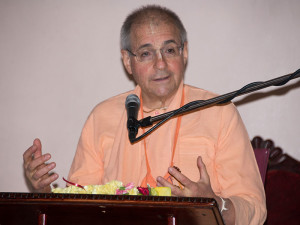 Giriraj Swami read and spoke from Sri Caitanya-caritamrta Madhya-lila 4.105-161.
Giriraj Swami read and spoke from Sri Caitanya-caritamrta Madhya-lila 4.105-161.
TEXT
gopinatha amara se eka-i anga haya
inhake candana dile habe mora tapa-kshaya
TRANSLATION
“There is no difference between My body and Gopinatha’s body. They are one and the same. Therefore if you smear the sandalwood pulp on the body of Gopinatha, you will naturally also smear it on My body. Thus the temperature of My body will be reduced.”
PURPORT by Srila Prabhupada
Gopala was situated in Vrindavana, which was far from Remuna. In those days, one had to pass through provinces governed by the Muslims, who sometimes hindered travelers. Considering the trouble of His devotee, Lord Gopala, the greatest well-wisher of His devotees, ordered Madhavendra Puri to smear the sandalwood pulp on the body of Gopinatha, which was nondifferent from the body of Gopala. In this way the Lord relieved Madhavendra Puri from trouble and inconvenience. —Cc Madhya 4.160
COMMENT by Giriraj Swami
“So, this is the beautiful relationship between the Lord and His pure devotee. The pure devotee is ready to take any trouble for the pleasure of the Lord: in fact, he doesn’t take it as trouble—he takes it as pleasure. Even though externally it may be very difficult, internally he takes it as pleasure, because he is able to serve his Lord. But the Lord, knowing the consciousness of His devotee, wants to serve His devotee by saving him the difficulty. This reciprocation is important for us to know because it will serve as a guideline for how we should act, and it will inspire in us greater appreciation for the Lords’ kind and merciful nature. Even though He is the Lord and is meant to receive all service, He is also a person and wants to reciprocate with His loving servant. If the devotee passes a test, then the Lord doesn’t want him to endure any more pain than necessary.”
May 6th, 2014 – Darshan – Chandan Yatra – Day 5
→ Mayapur.com
The post May 6th, 2014 – Darshan – Chandan Yatra – Day 5 appeared first on Mayapur.com.
Prabhupada Letters :: Anthology 2014-05-06 13:46:00 →
Prabhupada Letters :: 1968


